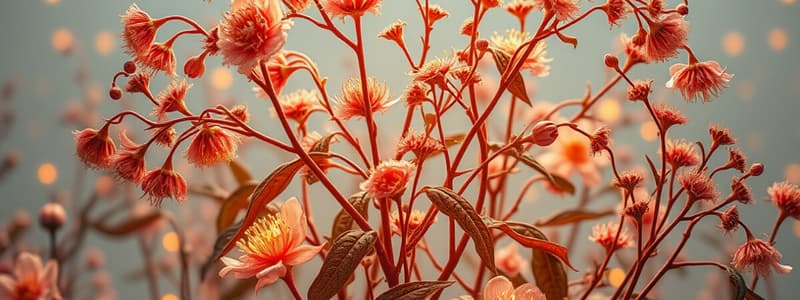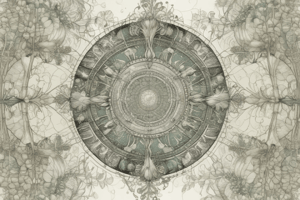Podcast
Questions and Answers
What is photoperiodism?
What is photoperiodism?
The term used to describe the influence of relative periods of light and darkness on flowering.
How do plants respond to their environment?
How do plants respond to their environment?
By hormones. They don't have a nervous system. They aren't fast responses compared to our nervous system; they are slow but sustained.
What environmental factors do plants respond to?
What environmental factors do plants respond to?
Light, phototropism, and photoperiodism.
How do plants monitor day length?
How do plants monitor day length?
What is Pr?
What is Pr?
What is Pfr?
What is Pfr?
What happens during daylight?
What happens during daylight?
What happens during night?
What happens during night?
What is the main form in daylight and why?
What is the main form in daylight and why?
What is the main form in darkness and why?
What is the main form in darkness and why?
Where is the stimulus (light) detected?
Where is the stimulus (light) detected?
How is flowering in plants initiated?
How is flowering in plants initiated?
Plants flower in response to....
Plants flower in response to....
What are the three groups that flowering plants can be divided into?
What are the three groups that flowering plants can be divided into?
What is a day neutral plant?
What is a day neutral plant?
What is a long day plant?
What is a long day plant?
What is a short day plant?
What is a short day plant?
A short day plant can only flower in the....
A short day plant can only flower in the....
A long day plant can only flower in the....
A long day plant can only flower in the....
Flashcards are hidden until you start studying
Study Notes
Photoperiodism
- Photoperiodism influences flowering in plants based on relative periods of light and darkness.
- Plants use hormones to respond to their environment, lacking a nervous system but exhibiting slow, sustained responses.
Plant Environmental Responses
- Light triggers phototropism, where shoots grow towards it.
- Photoperiodism allows plants to respond to light and dark periods, influencing flowering.
Monitoring Day Length
- Plants monitor day length using photoreceptors called phytochrome.
- Phytochrome absorbs specific wavelengths, specifically blue/green light, and exists in two inter-convertible forms: Pr and Pfr.
Phytochrome Forms
- Pr (phytochrome absorbing red light at 600nm) is dominant during daylight.
- Pfr (phytochrome absorbing far red light at 730nm) is predominant during the night.
Day and Night Phytochrome Dynamics
- During the day, Pr converts to Pfr rapidly.
- At night, Pfr converts back to Pr slowly, resulting in accumulation of Pr.
Light Detection and Flowering
- Light is detected in the leaves, with the stimulus transmitted to buds for flowering.
- Flowering is initiated by the hormone florigen.
- Day length is crucial for plant flowering responses.
Groups of Flowering Plants
- Flowering plants are categorized into three groups:
- Day Neutral Plants: Flowering unaffected by day length (e.g., cotton, tomato, cucumber).
- Long Day Plants: Require longer light periods, shorter darkness (e.g., cabbage, petunia).
- Short Day Plants: Require shorter light periods, longer darkness (e.g., tobacco, poinsettia).
Flowering Conditions
- Short day plants can only flower in darkness; interruptions by light prevent flowering.
- Long day plants can only flower in light; interruptions by darkness promote flowering.
Studying That Suits You
Use AI to generate personalized quizzes and flashcards to suit your learning preferences.




